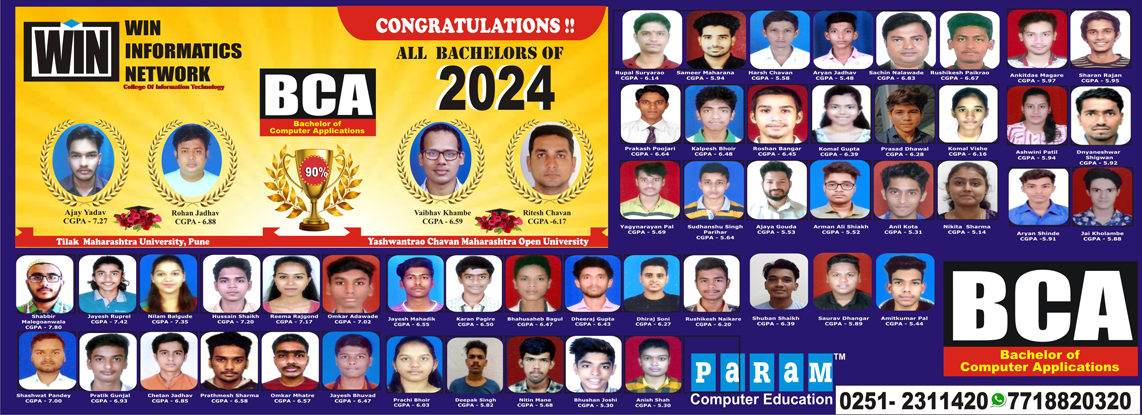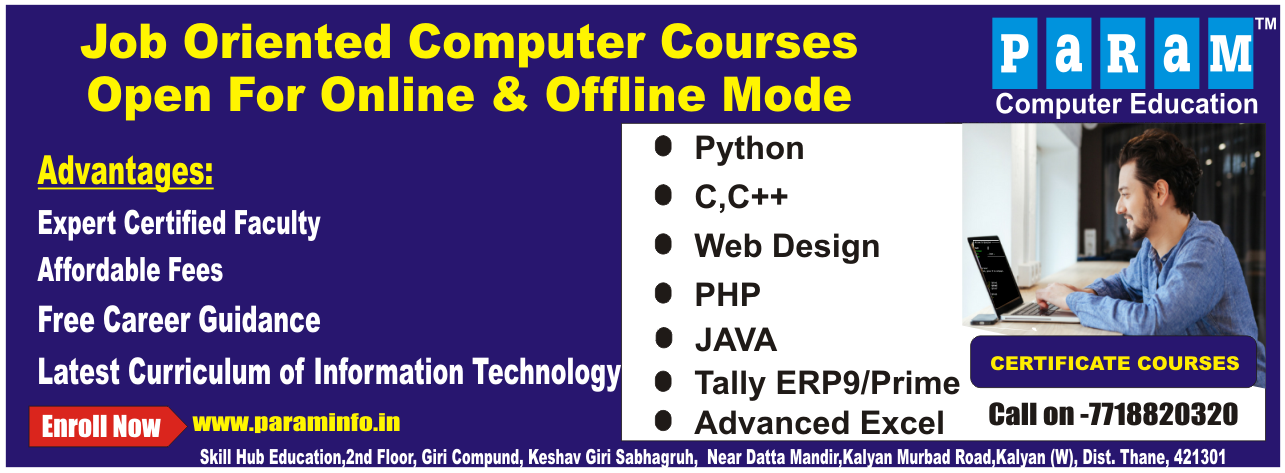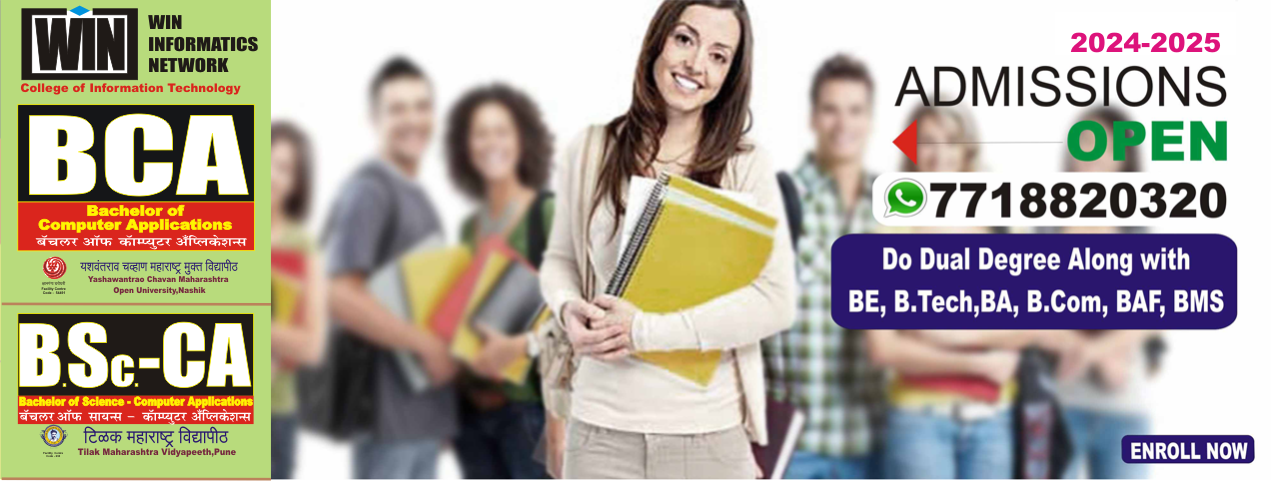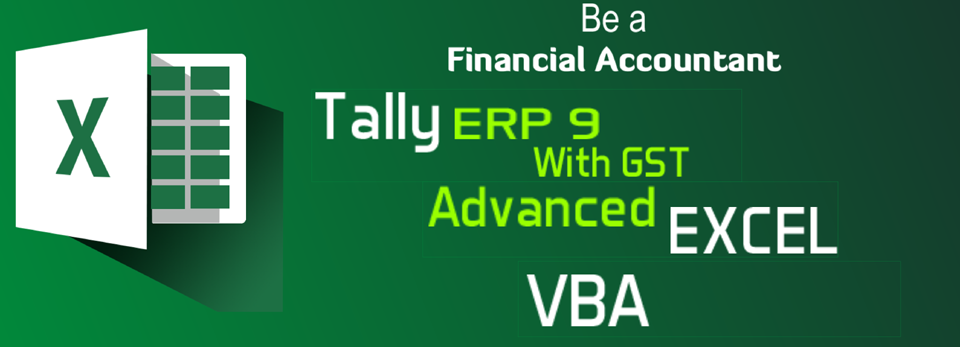| OOP with C# [ Duration 2 months ] |
- Introduction to C # : Evaluation of C#, characteristics of C#, application of C#, difference between C++ and C#, difference between Java and C#.
- Introduction to C# environment : The .NET strategy, the origins of the .NET technology, the .NET framework, the common language runtime, framework base classes, user and programs interface, visual studio .NET, .NET languages, benefits of the .NET approach, C# and .NET.
- Overview of C#: Programming structure of C#, editing, compiling and executing C# programs, namespace, comments, using aliases for namespace classes, using command line argument, maths function.
- Literals, variables and data types : literals, variables, data types, value types, reference tpye, declaration of variables, initialization of variables, default values, constant variables, scope of variables, boxing and unboxing.
- Operators and expression : arithmetic operators, relational operators, logical operators, assignment operators, increment and decrement operators, conditional operators,
Bitwise operators, special operators, arithmetic expressions, evaluation of expression, precedence of arithmetic operators, type conversions, operator precedence and associativity, mathematical functions.
- Decision making and branching: if statement, if....else statement, nesting of if....else statement, the else if ladder, switch statement, the ?: operator.
- Decision making and looping: while statement, do statement, for statement, for each statement, jumps in loops
- Methods in C# : declaring methods, the main method, invoking methods, nesting of methods, methods parameters, pass by value, pass by reference, the output parameters, variable arguments list, method overloading.
- Arrays : 1-D array, creating an array, 2-D array, variable size arrays, the system, array class, array list class.
- String handling: creating strings, strings method, inserting strings using systems, comparing strings, finding substrings, mutable strings, arrays of strings, regular expressions.
- Structures and enumeration: structures, structs with methods, nested structs, difference between classes and structs, enumerations, enumerator initialization, enumerator type conversion, common program errors.
- Classes and Objects : Basic principles of OOP's, class, objects, constructors, static members, static constructors, private constructors, copy constructors, destructors, member initialization, the this reference, nesting of classes, constant members, read only members, properties, indexers.
- Inheritance and polymorphism: classical inheritance, containment inheritance, defining a subclass, visibility control, defining subclass constructors, multilevel inheritance, hierarchical inheritance, overriding methods, hiding methods, abstract classes, abstract methods,
- Interfaces: Multiple Inheritance : defining an interface, extending an interface, implementing interface, interface & inheritance, explicit interface implementation, abstract class and interface.
- Operator overloading : overloadable operators, need for operator overloading, defining Operator overloading, overloading unary operators, overloading binary operators, overloading comparison operator.
- Delegates and Events : Delegate, delegate seclaration, delegate methods, delegates instantiation, delegate invocation, using delegates, multicast delegates, events.
- Managing Console I/O operations : console class, console input, console output, formatted output, numeric formatting, standard numeric format, custom numeric format.
- Managing Errors and Exceptions : Types of errors, exceptions, syntax of exception handling code, multiple catch statement, the exception hierarchy, general catch handler, using final statement, nested try blocks, throwing our own exceptions, checked and unchecked operators,
using exceptions for debugging.
^Top
|
| VB.net [ Duration 2 months ] |
- Introduction to VB.NET, IDE Environment, .NET Framework, .NET Architecture
- Console Application in VB.NET, .NET Execution model, Data types, Type Conversion, Language Terminology, Operators in VB.NET, Conditional Constructs, Decision Construct, Looping Statement
- Procedure and function in VB.NET (call by value, call by reference).
- Arrays , Enumeration and structure
- Object oriented concepts in VB.NET, Class, Properties and Methods, Constructor, Destructor, Method Overloading,
- Inheritance in VB.NET, Access Specifiers, Abstract Class , Final Classes, Method overriding, Shadows keyword
- Interfaces , Namespaces, Events, Delegates, Multithreading, Memory management in VB.NET, Garbage collector, Collections Classes
- Working with forms, controls in VB.net, Common Dialog Boxes, Error handling in VB.NET, Exception Handling, MDI Forms, Toolbars, Menus, Status bar
- GDI+ (Graphical Device Interface), FILE I/O, Assembly
- ADO.NET, ADO.NET advantages , ADO.NET Data Architecture, components DataSet and Data Provider, Objects of ADO.net, Connection, Command, DataReader, DataAdapter objects
- Crystal reports in VB.net
^Top
|
| ASP.Net with MVC 5 [ Duration 2 months ] |
- Introduction to ASP.NET 4, Microsoft .NET Framework, ASP.net Life Cycle, Web Application Development Process, Features of ASP.NET,
- Build a Simple Web Application, ASP.NetWeb Site Structure, ASPX Page Structure, ASP.NET Objects, Request and Response,
- Difference between HTML Controls and Server Controls, Types of Web Server Controls, Postback model, User Interface with HTML Controls and Web server Controls, Validation Controls
- Master Page, Content Page, nested Master Page, ViewState, ControlState, Application object and Session Object, Type of Session state, Global.asax
- Cascading Style Sheets (CSS), Web Navigation, The Sitemap File, Dynamic Menu, TreeView, User Controls
- ADO.NET
- ADO.NET Object Model, How to Create Connections, Data Binding Technique, Filter the data to display the selected Controls, Understand and Work in Connected & Disconnected Environment, Difference between Connected & Disconnected Environment,
- Retrieve and store large binary data. Bulk Copy Operations, SQL Notifications, Local Transaction and Distributed Transactions, Read, Write, Validate, and modify XML Data Using XML Classes, Read Write Operations of XML using DOM Object, Work with DataSet, Tables,
- Cystal reports.
- LINQ
- Operators, implementations,
- LINQ to objects, XML, ADO.NET, Query syntax
- ASP.NET Ajax
- Introduction AJAX, Using ASP.Net AJAX, Web Services and Page methods in AJAX websites.
- Data Caching
- Different Ways to Cache Data in asp.net Web applications
- Output Caching, Caching with Data Source Controls, Programmatic Caching
- Security in Your ASP.NET 4 Web Site
- Introducing security
- Introducing the login Controls
- JQuery
- Introduction to JQuery, JQuery syntax, modifying DOM with JQuery, effect with Jquery, Jquery and extensibilty.
- ASP.NET MVC 5
- ASP.NET MVC, Model-View-Controller Design Pattern, Routing, Controllers, Models, Views, Razor Syntax, HTML, Helpers, Using AJAX and jQuery with ASP.NET MVC
- Deploying Your Web Site
- preparing Your Web site for Deployment, Copying Your Web site, moving Data to a remote server
^Top
|
| Core Java [ Duration 2 months ] |
- Introduction to Java, Features of Java, Write, compile and run Simple Java Program
- What is JVM, Garbage Collection, define Class ,Variables, Functions , Access Specifies, How to work with Object, classes, and encapsulation, what is JRE, Data Types, Working with Identifiers, Control Statements, Arrays, Inheritance, Polymorphism, Overloading, verriding, Virtual Methods, Casting of Objects, Wrapper Classes,
- What is Package, Working with Java Supplied Packages, How to create packages, Exception Handling Techniques, Introduction to Set and List classes,
- Creating Applets and Frames using java supplied Packages (AWT),Components, Containers, Interfaces and Abstract Classes, AWT Components, Layout Managers, Working with Events, Event Delegation Model, Graphics,
- Exceptions,
- Creating Threads, Synchronization Threading
- File Input Output Operations
^Top
|
| Advance Java Level 2 [ Duration 2 months ] |
J2EE
- Swing introduction, Components , Java Foundation Classes (JFC), Frames, Panels, Applets, TextComponents, Buttons, Checkbox, Radio button, Lists, Combo box, Menus, JFC Menus components, Trees, JTable, Progress Bars, MVC
- JDBC(Database Connections) Explain the concept of database connectivity, Describe ODBC, Discuss what is JDBC, Discuss why we need JDBC, Describe the java.sql package in brief, Discuss types of drivers, Explain the anatomy of a JDBC program,The PreparedStatement interface, CallableStatement interface, DatabaseMetadata interface and its various methods, Work with ResultSets
- Networking, applets and URLs, Sockets, the java.net package, Applet-Applet Communication, Datagrams
- Remote Method Invocation (RMI), Java Distributed Object Model, what is RMI, The RMI architecture, java.rmi package, Sample RMI application
- What is a Java Bean? why we need Java Beans, NetBeans, simple bean example, Bean property issues
^Top
|
| Advance Java Level 3 [ Duration 2 months ]
|
Servlets
- Web-based Applications, Describe contemporary server-side technologies, Compare the contemporary server-side technologies with Servlet, Describe the advantages of using Servlet, Analyze the basic structure of a Servlet, The servlet life cycle,
- Work with Servlet APIs, Handle Servlet exceptions , Develop Servlets for gathering and sending HTML form data
- Session Management, Define a session, Describe various session tracking mechanism, Describe a session lifecycle, Implement session management using servlet APIs
- Java Database Connectivity in Servlets
- Servlet Communication and Servlet Context
JSP
- Describe the Web development process, Describe a typical server-side application, Using TCP / IP and HTTP protocols, Including GET, POST and Form Header methods
- Describe contemporary server-side technologies, Compare contemporary server-side technologies with JSP, Describe the advantages of using JSP
- Describe various elements of a JavaServer Page, Describe various JSP Tags in brief, Describe various Implicit Objects in JSP, Compare JSP and ASP
- Using JSP Scriptlets , Describe JSP tags in details, Define a JSP scriptlet , Explain the use of scriptlets in JavaServer Pages, Import a Java class, Describe the tag extension mechanism, Describe the JSP lifecycle
Using JavaBeans in JavaServer Pages, Describe various features of a Java bean, Differentiate between a Java bean and a Java class, Describe the basic structure of a Java bean, Describe various ways of creating Beans , Describe the advantages of using beans, Explain how to access beans through JSP scriptlets , Describe the use of various JSP bean tags, Define the scope beans
- Session Management, Define a Session ,Describe various session tracking mechanisms, Describe the various implementation of session tracking mechanisms through JavaServer Pages, Describe a session lifecycle
- Java Database Connectivity, Explain Java Database Connectivity, Describe various JDBC drivers available for JSPs, Explain the use of JDBC in JSPs, Describe different database operations, Explain the use of JDBC connectivity through JavaBeans in a JSP Describe the database
EJB
- Introduction to Application Server
- What is EJB-Container?Transaction Management, Security, Resource and life cycle, management, Remote Accessibility, Concurrency control, Clustering and load-balancing
- Enterprise Beans What is an enterprise bean, Benefits of enterprise beans, When to use enterprise beans, Types of enterprise beans
- eatures of EJB 3.0
- Annotations
- Session Beans What is a session bean, Types of session beans, Stateless Session Bean, Stateful session bean, When to use session bean, Life Cycle of Stateless session Life Cycle of Stateful session bean
Message Driven Beans
- Java Persistence APIJava Persistence API is the standard API used for the management of the persistent data and object/relational mapping. Java Persistence API is added in Java EE 5 platform. Every application server compatible with Java EE 5 supports the Java Persistent APIs.
- (Web application for java with additional fees)
Struts
- Introduction to Struts, Features of Struts, Designing Web Application using Struts MVC framework, Struts Action class, Configuring Struts action mappings.
^Top
|
| HTML 5 [ Duration 1 month ] |
- Introduction to HTML
- Concept of Tags
- Basic HTML Tags Introduction
- Viewing Code as Output
- Font Tag Properties and Style Tags
- Using Image Tag and Properties
- Displaying Marquee Effect to Text and Image
- Applying Lists in HTML
- Creating Table using Tags
- Applying Internal and External Hyperlinks to Text and Images
- Using mailto attribute
- Image Maps
- Working with Frames
- Linking Frames and Using Target Attribute
- Inline Frame
- HTML Entities, Abbreviations and Citations
- Adding Sound and Video to Webpage
- Creating HTML Forms
- Introduction to HTML 5
- New Elements
- Semantics
- Migration
- Canvas
- Google Maps
^Top
|
| Bootstrap [ Duration 1 month ] |
- Introduction to Bootstrap
- Typography
- Responsive Tables and Images
- Buttons and dropdowns
- Pagination
- Panels
- Collapse
- Tabpanel
- Navigation
- Forms
- Carousel
^Top
|
| JavaScript [ Duration 1 month ] |
- Introduction to JavaScript, JavaScript Statements, Use of variables and Operators,
- Conditional Constructs, Looping Constructs,
- Events, Exception handling Techniques,
- JavaScript Objects (String, date, array, math),Validations , Cookies, Session Management, use of DOM.
^Top
|
| AngularJS [ Duration 2 months ] |
- AngularJS Introduction, AngularJS Applications,
- AngularJS Expressions,
- AngularJS Modules, Creating a Module,
Adding a Controller,
Adding a Directive,
Modules and Controllers in Files
- AngularJS Directives, Data Binding,
Repeating HTML Elements
,The ng-app Directive,
The ng-init Directive
- The ng-app Directive,
Two-Way Binding,
Validate User Input,
Application Status,
CSS Classes
- AngularJS Controllers,
Controller Methods,
Controllers In External Files,
AngularJS Scope
- AngularJS Filters,
Adding Filters to Expressions,
Adding Filters to Directives,
The currency Filter,
The filter Filter
- AngularJS Services, The $http Service,
The $timeout Service,
The $interval Service
- AngularJS Tables,
Displaying Data in a Table,
Displaying with CSS Style,
Display with orderBy Filter
- AngularJS SQL,
Fetching Data From a PHP Server Running MySQL,
Fetching Data From an ASP.NET Server
- AngularJS HTML DOM,
The ng-disabled Directive,
The ng-show Directive,
The ng-hide Directive
- AngularJS Events,
AngularJS Forms,
AngularJS Form Validation
- AngularJS API,
AngularJS and W3.CSS,
AngularJS Includes,
AngularJS Animations,
AngularJS Routing
^Top
|
| jQuery [ Duration 1 month ] |
- Introduction
- Syntax
- Selectors
- Events
- Effects (Show, Hide, Animate, Stop etc.)
- jQuery HTML
^Top
|
| PHP Hypertext Preprocessor (PHP) [ Duration 1.5 month] |
- Introducing PHP,PHP Language Basics ,Decisions and Loops,,
- Strings, Arrays,
- Functions,
- Objects ,Handling
- HTML Forms with PHP
- Preserving State With Query Strings,
- Cookies, and Sessions ,
- Working with Files and Directories ,
- Introducing Databases and SQL,Retrieving Data from MySQL with PHP,Manipulating MySQL Data with PHP,
- Making Your Job Easier with PEAR
- String Matching with Regular Expressions,
- Working with XML,
^Top
|
| ASP [ Duration 1 month ] |
- Introduction to ASP, Variables, Data types, Operators, Procedures, Forms, Cookies,
- ASP Objects like, Session, cookies, server, Application, Request, Response.
- Difference between Application and Session.
- Objects ,HandlingData Connection with Database.
- HTML Forms with PHPADO Object Model. Global.asa file
- ASP Components like Ad Rotator, Browser Cap, etc.
^Top
|
| XML [ Duration 1 month ] |
- Introduction to XML, Structure of XML Document, Creating XML Schema, Use Attributes in XML Schema,
- need of XML Namespace, Reuse of XML Schema, Components Creating Group of Elements and attributes, How to Use CSS in XML,
- How to Use XSLT, Conditional Formatting, XPath Pattern, Documents and DTDs, PCDATA, Converting XML document to HTML,
- DOM Object
^Top
|
| C Programming [ Duration 1.5 month ] |
- Introduction to flowchart & Concept Of Programming Languages & Generations
- Beginning With 'C' & Input & Output Operations.
- Operators in C
- Control Statements (conditional & looping statement)
- Arrays in C
- Functions in C
- Pointers & dynamic memory allocation
- Storage classes
- Structures, unions & user defined datatypes in C
- Preprocessors
- File handling
^Top
|
| C++ [ Duration 1.5 month ] |
- Introduction to OOP Concepts, Object Oriented Methodology,
- Basic of C++
- Functions in C++
- Classes and Objects
- Constructor / Destructor, Static members, Friend function
- Operator Overloading
- Inheritance & Polymorphism
- Console I/O, File I/O
- Template, Exception Handling
^Top
|
| Data Structures with C [ Duration 2 months ] |
- Basics of C, Types of Data Structure, Linear and Non-Linear Data Structure, Arrays, Searching and Sorting techniques
- Linked List, Types of Linked List, Use of Input Output Operations, Singly Linked List, Doubly Linked List, Circular Linked List.
- Stack and Queues
- Binary tree
- Graphs
^Top
|
| Datastructure Using C++ [ Duration 2 months ] |
- Basics of C++, Types of Data Structure, Linear and Non-Linear Data Structure, Arrays, Searching and Sorting techniques
- Linked List, Types of Linked List, Use of Input Output Operations, Singly Linked List, Doubly Linked List, Circular Linked List.
- Stack and Queues
- Binary tree
- Graphs
^Top
|
| Python [ Duration 1 month ] |
- Introduction
- Data and Expressions
- Lists
- Functions
- Objects and Their Use
- Modular Design
- Text files
- Dictionaries and Sets
- Object Oriented Programming
- Recursion
- Graphical User Interfaces
- Database accessing
- Networking
- Multithreading
^Top
|
| Access Fundamentals [ Duration 1 month ] |
- What’s New In Microsoft Access 2010
- Basics of Database Concepts,
- Difference between DBMS and RDBMS
- Creating Tables using Table design and Datasheet
- Primary key and relationship
- Creating Select Queries
- Create Form Using Form Wizard
- Append, Update and Delete Data into Table Using Form
- Creating and Printing Report Using Report Wizard
- Importing External Data
^Top
|
| SQL Server 2008 [ Duration 2 months ] |
RDBMS
- What is Database, use of Database, difference between DBMS and RDBMS?
- Work on Relational Operators, What is Object, Entity, Attributes, Properties
- What is Projection, What is Selection, Types of Models
- What is Normalization, Types of Normalization, Types of Constraints and Types of Relationships.
SQL Server
- Introduction to SQL: The SQL language, role of SQL, SQL features & benefits
Microsoft commitment (ODBC & ADO) , Internet database access , Java integration
(JDBC))
- SQL & DBMS: Brief history of SQL , SQL Standards ( ANSI / ISO Standards,
other SQL standards, ODBC & the SQL access group) , SQL & networking (
centralized architecture, file server architecture , client/server architecture, multi-tier architecture)
- RDBMS: Data models (File management systems, hierarchical databases,
network databases), relational data model ( Keys, tables, relationships), Codd's 12 rules
- SQL Basics: statements, names ( table & column names), data types , constants
(numeric, string, date & time, symbolic constants), expressions , built-in functions, missing data (NULL values)
- Database updates : adding data to the database , deleting data from the
database, modifying data in the database
- Creating a database : DDL, creating database , table definitions, constraint
definition, aliases & synonyms, indexes, managing other database objects, database structures ( single database architecture, multi- database architecture, multi-location database architecture)
- Simple queries: The SELECT statement , query results, simple queries, duplicate rows, row selection, search conditions, sorting query results, rules for single table query processing
- Multi-table queries : Simple joins , Non equi-joins, SQL considerations for multi table queries ( table aliases, qualified column names, all column selections , self joins) , multi table query performance , the structure of the join ( table multiplication, rules for multi-table query processing ) , outer joins.
- Summary Queries : column functions, grouped queries, group search conditions.
- Sub queries & query expressions : using sub queries, sub query search conditions, sub queries & joins, nested sub queries , correlated sub queries, sub queries in the HAVING clause, advanced queries in SQL2 .
- Data integrity : meaning of data integrity, required data, simple validity checking (column check constraints, domains ), entity integrity ( other uniqueness constraints, uniqueness & NULL values) , referential integrity ( referential integrity problems, delete & update rules, cascaded deletes & updates, referential cycles, foreign keys & NULL values)
- Transaction Processing : Meaning ( COMMIT, ROLLBACK), transaction log,
transaction & multi user processing, locking ( locking levels, shared & exclusive locks, deadlocks, advanced locking techniques)
- Views : meaning, creating a view ( horizontal, vertical, row/column subset,
grouped , joined views ), updating a view, dropping a view
- Stored Procedures and Functions
- Triggers
- SQL security : SQL security concepts ( user-ids, security objects, privileges ) , views & SQL security, granting privileges , revoking privileges
^Top
|
| Oracle 10G [ Duration 2 months ] |
SQL
- Introduction to DatabasesCODD'S Rules
- Data types and Creating Tables
- Oracle Data Manipulation Language (INSERT, UPDATE, DELETE, INSERT ALL, MERGE)
- Oracle Data Definition Language (CREATE, ALTER, DROP, TRUNCATE, RENAME)
- Oracle SQL SELECT Statement
- UNION, INTERSECT, MINUS Operators and Sorting Query Result
- Oracle SQL Functions (Character Functions, Math Functions, Aggregate Functions)
- Oracle Join Queries, (Inner Join, Outer Join, Self Join)
- GROUP BY Queries, SUB Queries, CUBE, ROLLUP Functions, WITH, CASE Operators
- Oracle Integrity Constraints (PRIMARY KEY, NOT NULL, CHECK, FOREIGN KEY, UNIQUE)
- Oracle Transaction Control Language (COMMIT, ROLLBACK,SAVEPOINT)
- Data Control Language (GRANT, REVOKE)
- Oracle Date Operators, Functions
- Managing Oracle Views
- Managing Oracle Sequences and Synonyms
- Managing Indexes and Clusters
- Oracle Table Partitioning and Creating Partitioned Tables
- Oracle Objects and Object Types
PLSQL
- Introduction to PL/SQL, Advantages of PL/SQL, PL/SQL Variables
- PL/SQL Constants
- PL/SQL Records
- PL/SQL Conditional Statements
- PL/SQL Iterative Statements
- PL/SQL Cursors
- PL/SQL Explicit Cursors
- PL/SQL Procedures
- PL/SQL Functions
- Parameters-Procedure, Function
- PL/SQL Exception Handling
- PL/SQL Triggers
- PLSQL-Packages
^Top
|
| Tally.ERP 9.0 (Government Certification) [ Duration 1.5 month ] |
Basic Tally ERP 9.0
- Basic Accounting Concept & Financial Management
- ERP Concept & Features of Tally.ERP9 and their uses
- Company Creation, Setting Up/Classification Of Accounts
- Inventory features & maintenance of stock
- Accounting & inventory vouchers in Tally ERP 9.0
Advanced Tally ERP 9.0 with GST
- Tax Deducted at Source (TDS)
- POS, Cost center & payroll information & report generation
- Goods and Services Tax (GST)
- Purchase & Sales Voucher with GST
- GST Reports and Returns
^Top
|
| Excel [ Duration 1 month ] |
- Autofill formulas : Copy cells, Fill formatting only, Fill without formatting
- Relative, absolute, and mixed cell references : Changing the cell reference from relative to absolute
- Formating cells : Number format, Currency, Date, Time, Text, Custom Number Formats
- Functions and formulas :
- Basic functions: Auto sum, Sum, Average, Max, Min
- Text functions: Upper, Lower, Proper, Left, Right, Mid, Concatenate, Len, Exact, Search, Replace, Text
- Maths Functions : Abs, Int, Mod, Sqrt, Power, Round, Trunc, product, ceiling,
- Statistical Functions : countA, countBlank, small , large
- Conditional Functions: If, Nested ifs
- Logical functions: And, Or, Not
- Trace precedents, Trace dependents, Show formulas, Conditional formatting
- Sort & filter : Sort sheet, Sort range, Ascending sort, Descending sort, Auto filter
- Group, Ungroup, Subtotal, Chart, Hyperlink
- Freeze Panes
^Top
|
| Advanced Excel [ Duration 1 month] |
- Date and Time Functions: Date,Today, Now, Day, Month, Year, Time, Hour, Minute, Second, Weekday
- Conditional Functions: Sumif, Sumifs, Countif , Countifs
- Information Functions: IsBlank, IsError, Isnumber, Istext
- Lookup Functions: Vlookup, Hlookup
- Financial functions: PMT, Rate, Nper, Pv, fv
- Advanced filter, Data validation, Consolidate
- What if analysis: Scenario manager, Goal seek, Data table
- Remove Duplicates, Text to columns
- Pivot table and MIS report, Pivot chart
- Protect sheet: Protect sheet, Hide formula, Lock cell, Unlock cell, Protect workbook, Share workbook, Track changes
- Macro: Record macro, Run macro
^Top
|
| VBA [ Duration 1 month ] |
1. Introduction to VBA
2.How VBA works with Excel
- Working with the Visual Basic Editor
- Introducing the EXCEL Object model
- VBA sub and Function Procedures
- Using the Excel Macro recorder
3.Programming Concepts
- Essential Language elements
- Working with range objects
- Using VBA and Worksheet functions
- Controlling program flow and making decision
- Automatic procedures and events
- Error handling techniques
- VBA programming examples
4.Communicating with your users
- Simple dialog box
- Userform basics
- Using userform control
- User form techniques and tricks
- Accessing your macro using user interface
|
| XII Bi Focal CS/IT [ Duration 6 months ] |
Paper I
- Operating Systems
- Data Structure
- C++
- Objects ,HandlingData Connection with Database.
- HTML
Paper II
- Introduction to Microprossors and Organisation of 8085
^Top
|
Computer Fundamentals: [ Duration 1 month ] |
- Introduction to Computers
- Computer Components
- Generation of Computer
- Classification of Computer
- Input Output Devices
- Memory Types
- Primary and Secondary Storage
- Add-on cards
- Ports
- Computer Software and Programming Languages.
^Top
|
| Networking Fundamentals: [ Duration 1 month ] |
- Networking Concept
- Classification of Network
- Network Topology
- Communication Channels
- Introduction to OSI Layers
^Top
|
| Windows 7: [ Duration 1 month ] |
- What is Operating System?
- Features of Operating System
- Introduction to Windows Operating System
- Features of Windows 7
- Exploring Windows Desktop, Taskbar and Start Menu
- Creation of Files and Folders
- Accessories Windows Explorer
- Windows Search utility,
^Top
|
| Internet and Email: [ Duration 1 week ] |
- Introduction to Internet,
- History & Features of Internet,
- Concept of Website and WebPages
- Introduction to World Wide Web (WWW),
- Internet Protocols
- Working with Email
- Using Search Engine
^Top
|
| Ms-Office 2010 [ Duration 2 months ]
|
- What’s New In Microsoft Word 2010
- Managing Document (opening, saving and printing etc.)
- Editing and Formatting Document Text
- Applying Bullets and Numbering
- Customizing Header and Footer
- Adding Bookmarks and Hyperlinks
- Adding Tables, Pictures, clipart and Charts.
- Creating Table Of Content ,
- Creating Caption for tables and Figures
- Working with Footnotes and Endnotes
- Applying Mail Merge Feature and Printing Envelopes
- Spelling and Grammar checks and Comments
- Working with Document Views
|
- What’s New In Microsoft PowerPoint 2010
- Creating Presentations using Slides
- Adding New Slide and Slide Layouts
- Applying Table, Picture, clipart and Charts to Slides
- Adding media Clips to Slides
- Applying Slide Design
- Using Action Buttons for Slide Navigation
- Animation and Transition Effects
- Slide Show and Set Up features
- Exploring Different Presentation Views
^Top
|
| Programming and Logical Techniques [ Duration 1 month ] |
- What is Programming
- An Overview of Computer Logic
- What is Flowchart,
- Advantages of Flowchart,
- Drawing Flowcharts
- Performing Conditional checks and Repetitions
^Top
|
Software Engineering (SDLC/UML) [ Duration 1 month ] |
- Overview of UML, Evaluation of UML, Scope of UML, Identifying UML Diagrams, Defining Diagrams like Class, Use Case, Object, Communication, Introduction to Diagrams like State, Sequence, Activity, Package, Component, Class, Object, Diagrams like Development, Timing.
- Composite Structure, Interaction Diagrams, Identify Role of UML in SDLC, Identify Rational Unified Process, Benefits of RUP , Life Cycle of RUP, Defining System, Business Modeling, System Modeling, Identifying Stakeholders, Identifying System Boundary, Project Scope, Refining Use Case, Identifying Deriving and Creating Interfaces.
- Data Elements, Screen Designers, Systems Documentation
^Top
|
| Software Quality Testing [ Duration 1 month ] |
- What is SQT, Quality Assurance, Difference between Quality Assurance and Quality Control,
- Role of Metrics in Quality Assurance, Benefits of Early Testing, Test Specifications,
- Life Cycle of Testing, Role & Responsibility of Software Tester, Phases of Test Planning Process,
- Explain V Model and W Model, Testing Approaches,
- Various Types of Testing Tools, Unit Testing, Integration Testing, System Testing, Results, Acceptance Testing,
- Steps in Defect Discovery, Strategies of Test Defects, Types of Process, Test Metrics, Test Reports Tools. SDLC (Software Development Life Cycle)
^Top
|
Linux [ Duration 1 month ] |
- Linux Operating System history. Basic features of Linux. Advantages of Linux.Basic architecture of Unix/Linux operating system. Overview of Linux kernel, kernel space, user space. System initialization . Linux file system architecture. Directory structure of Linux. Hardware requirement for Linux operating system
- Basic Linux commands – cd , rm , touch, cat , mkdir , ls , date , cal pwd, file, login, logout, shutdown etc. Linux boot sequence. Different services in Linux – init services, xinetd services , sys V launched services. Daemon services. Standard input and output operators in Linux. Shells in Linux. Bash shell features.
- Difference between Application and Session.
- File Management in Linux. ,File structure in Linux. Disk partitioning, managing partitions, making file systems, mount points and /etc/fstab. Mouting file system with mount. Unmounting file system. Managing swap partitions and swap files. Mounting NFS files systems.
- Backup Management In Linux,Archiving tools – Tar command, dump/restore command. Gzip, bzip2 gunzip and bunzip2 commands.
- Package management in Linux. Study of rpm (Red Hat Packager) in details Print management in Linux. Study of printing commands.
- User Administration in Linux, Adding new user account, creating groups, modifying /deleting user accounts, password aging policies, usermod command. Study of /etc/passwd, /etc/shadow and /etc/groups files. Switching users using su command.
- File permissions in Linux,Default file permissions, changing file permissions, chmod and chown commands, special file permissions – SUID, SGID and stickybit.
- Shell Programming ,Basic shell programming, shell programming in bash shell. Read command, conditional and loop statements. Case statements, parameter passing and arguments, shell variables, shell keywords, creating shell programs for automatic system tasks.
^Top
|
^Up
|







 1
1 2
2 3
3 4
4 5
5 6
6